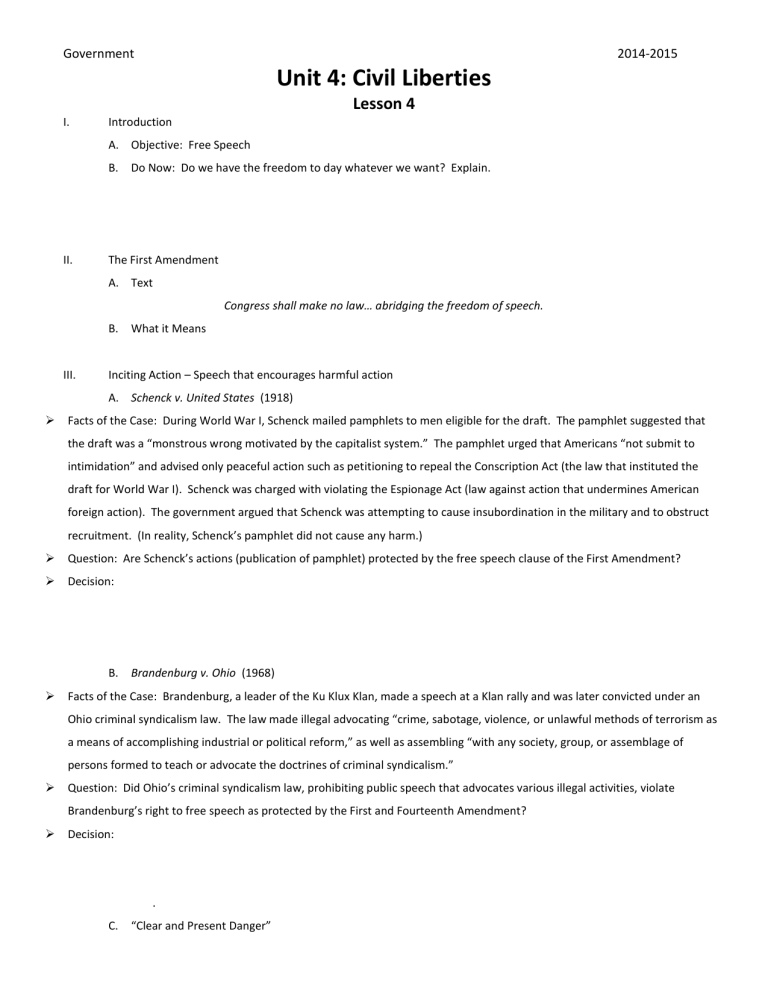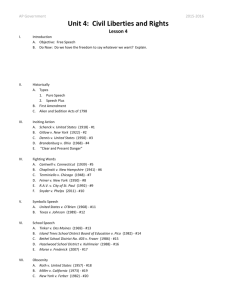Civil Liberties Lesson 4

I.
Government
Unit 4: Civil Liberties
Lesson 4
Introduction
A.
Objective: Free Speech
B.
Do Now: Do we have the freedom to day whatever we want? Explain.
2014-2015
II.
The First Amendment
A.
Text
Congress shall make no law… abridging the freedom of speech.
B.
What it Means
III.
Inciting Action – Speech that encourages harmful action
A.
Schenck v. United States (1918)
Facts of the Case: During World War I, Schenck mailed pamphlets to men eligible for the draft. The pamphlet suggested that the draft was a “monstrous wrong motivated by the capitalist system.” The pamphlet urged that Americans “not submit to intimidation” and advised only peaceful action such as petitioning to repeal the Conscription Act (the law that instituted the draft for World War I). Schenck was charged with violating the Espionage Act (law against action that undermines American foreign action). The government argued that Schenck was attempting to cause insubordination in the military and to obstruct recruitment. (In reality, Schenck’s pamphlet did not cause any harm.)
Question: Are Schenck’s actions (publication of pamphlet) protected by the free speech clause of the First Amendment?
Decision:
B.
Brandenburg v. Ohio (1968)
Facts of the Case: Brandenburg, a leader of the Ku Klux Klan, made a speech at a Klan rally and was later convicted under an
Ohio criminal syndicalism law. The law made illegal advocating “crime, sabotage, violence, or unlawful methods of terrorism as a means of accomplishing industrial or political reform,” as well as assembling “with any society, group, or assemblage of persons formed to teach or advocate the doctrines of criminal syndicalism.”
Question: Did Ohio’s criminal syndicalism law, prohibiting public speech that advocates various illegal activities, violate
Brandenburg’s right to free speech as protected by the First and Fourteenth Amendment?
Decision:
.
C.
“Clear and Present Danger”
Government
IV.
Fighting Words – speech that instigates violence
2014-2015
A.
Chaplinski v. New Hampshire (1941)
Facts of the Case: Chaplinsky, a Jehovah’s Witness, called a city marshal a “God-damned racketeer” and “a damned fascist” in a public place. He was arrested and convicted under a state law for violating a breach of peace.
Question: Does the application of the statute violate Chaplinsky’s freedom of speech protected by the First Amendment?
Decision:
B.
Snyder v. Phelps (2011)
Facts of the Case: The family of deceased Marine Lance Cpl. Matthew Snyder filed a lawsuit against members of the Westboro
Baptist Church who picketed at his funeral. The family accused the church and its founders of defamation, invasion of privacy, and the intentional infliction of emotional distress for displaying signs that said, “Thank God for dead soldiers” and “Fag troops” at Synder’s funeral. A U.S. District Court awarded the family $5 million in damages but an Appeals Court ruled that the judgment violated the First Amendment’s protection on expression. The church members’ speech is protected,
“notwithstanding the distasteful and repugnant nature of the words.”
Question: Does the First Amendment protect protesters at a funeral from liability for intentionally inflicting emotional distress on the family of the deceased?
Decision:
V.
Symbolic Speech – action with the purpose of expressing ideas and/or opinions
A.
Texas v. Johnson (1989)
Facts of the Case: In 1984, in front of the Dallas City Hall, Gregory Lee Johnson burned an American flag as a means of protest against Reagan administration policies. Johnson was tried and convicted under a Texas law outlawing flag desecration. He was sentenced to one year in jail and assessed a $2,000 fine.
Question: Is the desecration of an American flag, by burning or otherwise, a form of speech that is protected under the First
Amendment?
Decision:
VI.
School Speech – do students have First Amendment rights?
A.
Tinker v. Des Moines (1969)
Facts of the Case: In December 1965, a group of students in Des Moines, Iowa, held a meeting in the home of 16-year-old
Christopher Eckhardt to plan a public showing of their support for a truce in the Vietnam War. They decided to wear black armbands throughout the holiday season and to fast on December 16 and New Year’s Eve. The principals of the Des Moines schools learned of the plan and met on December 14 to create a policy that stated that any student wearing an armband would
Government 2014-2015 be asked to remove it, with refusal to do so resulting in suspension. On December 16, Mary Beth Tinker and Christopher
Eckhardt wore their armbands to school and were sent home. The following day, John Tinker did the same with the same result. The students did not return to school until after New Year’s Day, the planned end of the protest. Through their parents, the students sued the school district for violating the students’ right of expression and sought an injunction to prevent the school district from disciplining the students.
Question: Does a prohibition against the wearing of armbands in public school, as a form of symbolic protest, violate the students’ freedom of speech protections guaranteed by the First Amendment?
Decision:
B.
Bethel School District v. Fraser (1986)
Facts of the Case: At a school assembly of approximately 600 high school students, Matthew Fraser made a speech nominating a fellow student for elective office. This was his speech:
“I know a man who is firm – he’s firm in his pants, he’s firm in his shirt, his character is firm – but most of all, his belief in you the students of Bethel, is firm. Jeff Kuhlman is a man that takes his point and pounds it in. If necessary, he’ll take an issue and nail it to the wall. He doesn’t attack things in spurts – he drives hard, pushing and pushing until finally – he succeeds. Jeff is a man who will go to the very end – even the climax, for each and every one of you. So please vote for Jeff Kuhlman, as he’ll never come
[long pause] between us and the best our school can be. He is firm enough to give it everything.”
Observers believed his speech was a graphic sexual metaphor to promote the candidacy of his fried. As part of its disciplinary code, Bethel High School enforced a rule prohibiting conduct which “substantially interferes with the educational process… including the use of obscene, profane language or gestures.” Fraser was suspended from school for two days.
Question: Does the First Amendment prevent a school district from disciplining a high school student for giving a lewd speech at a high school assembly?
Decision:
C.
Hazelwood School District v. Kuhlmeier (1988)
Facts of the Case: The Spectrum, the school-sponsored newspaper of Hazelwood East High School, was written and edited by students. In May 1983, the school principal received the pages proofs for the May 13 issue and found two of the articles to be inappropriate so he ordered those articles to be withheld from publication. Cathy Kuhlmeier and two other former Hazelwood
East students brought the case to court.
Question: Did the principal’s deletion of the articles violate the student’s rights under the First Amendment?
Decision:
Government
D.
Morse v. Frederick (2007)
2014-2015
Facts of the Case: At a school-supervised event, Joseph Frederick held up a banner with the message “Bong Hits 4 Jesus,” a slang reference to marijuana smoking. Principal Deborah Morse took away the banner and suspended Frederick for ten days.
She justified her actions by citing the school’s policy against the display of material that promotes the use of illegal drugs.
Frederick sued alleging a violation of his First Amendment right to freedom of speech.
Questions: Does the First Amendment allow public schools to prohibit students from displaying messages promoting the use of illegal drugs at school-supervised events?
Decision:
VII.
Obscenity – is obscenity protected under the First Amendment?
A.
Roth v. United States (1957)
Facts of the Case: Roth operated a book-selling business in New York and was convicted of mailing obscene circulars and an obscene book in violation of a federal obscenity statute.
Question: Did the federal obscenity restriction, prohibiting the sale or transfer of obscene materials through the mail, impinge upon the freedom of expression as guaranteed by the First Amendment?
Decision:
B.
Miller v. California (1973)
Facts of the Case: Miller, after conducting a mass mailing campaign to advertise the sale of “adult” material, was convicted of violating a California statue prohibiting the distribution of obscene material. Some unwilling recipients of Miller’s brochures complained to the police, initiating the legal proceedings.
Question: Is the sale and distribution of obscene materials by mail protected under the First Amendment’s freedom of speech guarantee?
Decision:
C.
New York v. Ferber (1982)
Facts of the Case: A New York child pornography law prohibited persons from knowingly promoting sexual performances by children under the age of 16 by distributing material which depicts such performances.
Question: Did the law violate the First and Fourteenth Amendments?
Decision:
Government
VIII.
Conclusion
2014-2015
A.
The concept of free speech has been constantly challenged, re-evaluated, and redefined since the writing of the
Constitution.
B.
The country and the culture have evolved beyond what the Framers of the Constitution envisioned. The
Supreme Court has repeatedly ruled on when speech is allowed and when speech is prohibited.
C.
The Supreme Court has historically been reluctant to limit speech unless it is a threat to public safety or a national security risk. However, these instances are often difficult to pinpoint, and courts generally err on the side of protecting speech.
D.
Most forms of symbolic speech are protected; however, there are limitations. For example, the government is often allowed to regulate speech that occurs in a public forum or in special facilities such as military bases, schools, and prisons. Other limits of free speech involve obscenity, defamation, commercial speech, and speech that leads to unlawful action.
Key Terms, Concepts, Events, People, and Places:
Pure Speech Symbolic Speech First Amendment Schenck v. United States
Brandenburg v. Ohio
Chaplinsky v. New Hampshire
“Clear and Present Danger” “Dangerous Tendency” Test
Snyder v. Phelps Texas v. Johnson
Hazelwood v. Kuhlmeier
Questions to Consider:
Roth v. United States Miller v. California
Fighting Words
Tinker v. Des Moines
1.
How would you explain the “Clear and Present Danger” limit on our freedom of speech? Back up your explanation with cases.
2.
Are “fighting words” protected under the First Amendment? Explain using cases.
3.
What is symbolic speech and why is it protected by the First Amendment? Explain using cases.
4.
How are First Amendment rights guaranteed to students? How are First Amendment rights limited for students? Explain using cases.
5.
Is obscenity protected under the First Amendment? Explain using cases.





